KADAVU ISLAND
The passage from Suva to Kadavu is across Kadavu Passage which has a reputation for often being quite rough; however, it was beautifully calm the night we sailed it. We planned on making landfall at Kavala Bay on Kadavu, and we did not want to enter until daylight, but we took advantage of the calm conditions and made the crossing during the early hours of the night, then we hove to until mid-morning. (It is prudent not to do any near-shore sailing in Fiji at night.)
Kadavu is a large island – almost 175 square miles. However, it has no vehicles or roads. There are some paths between a few villages, but most transportation is by water.
Until recently, Kadavu’s main source of income was yanqona. Supposedly Kadavu grows Fiji’s best yanqona – and that is an important achievement in a nation that values their grog the way the Fijians do.
However, in recent years, Kadavu has begun to develop a tourism industry on its own small scale. There are now daily flights from Suva and Nadi, and there are a few small ‘resorts’ and dive operations. This small scale tourism is now Kadavu’s primary source of income, and other islands look at Kadavu as an example of how to develop a source of income.
Small resorts are now scattered around much of the perimeter of the island. However, our plans were to visit only the north and east shores. We know we can’t see it all.
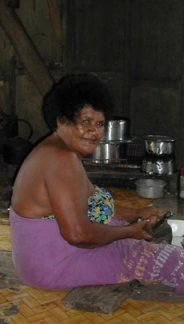
Chief’s wife grating coconut
During a rain break, we took the dinghy up a passage through the mangroves to the edge of the village of Lewaki. We found a dugout canoe and a bamboo raft, but nobody was there with them. It was late in the day, and we had not received an invitation to visit the village, so we went back to Passage. And the rain prevented us from going there again and climbing the waterfall that we wanted to see.
We went by Kavala numerous times, and we caught a few fish off their shore. We also received an invitation to visit, but we never made it ashore there.
And we were never in the water when the tide was high enough to visit Naboutini. The few people living there must know a way in that we never found.
So most of our limited shore time was at Vunivaivai. But that was ok. It was a great spot. There is a large population of fruit bats there that kept us entertained each evening – even when the weather was lousy.
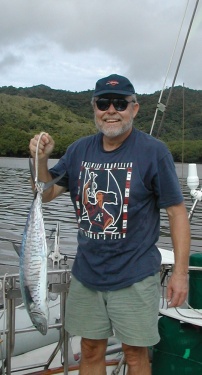
Bud’s walu
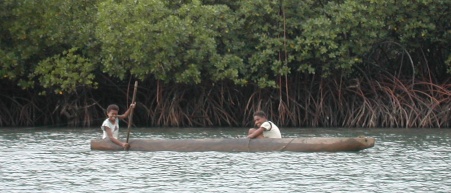
Kids in dugout canoe
Connie came by every few days (when the rains permitted), and her welcoming hospitality was very special. She brought us fish, fruits, and veges, and we learned about Kadavu from her. She and Bud went fishing together on a rainy day and caught a very nice job fish. We sent it with her to give to her village chief, Belou Kele Kele. Then Connie caught a huge walu (Spanish mackerel) on her way out of the bay which she came back to show us (walu has become our favorite fish since arriving Fiji). Connie is a very accomplished fisher with a reputation around the island.
Belou Kele Kele and her husband, Salimoni, also stopped by one day to say ‘thank you’ for the fish. She is a good friend of Connie’s, and any friend of Connie’s is a friend of hers. She is a rather powerful chief in these parts, and she offered to go with us to make sevusevu anywhere we wanted so as to ‘open the doors’ for us. She is a delightful woman, and we appreciated her generous offer even though we never took her up on it.
We also had a very brief visit from Tom Bashaw whom we knew in Honolulu. Tom has the Ala Wai Yacht Brokerage there, and we have known him for a few years. He is also building at Waisalima, and he was here working on his house. Small world.
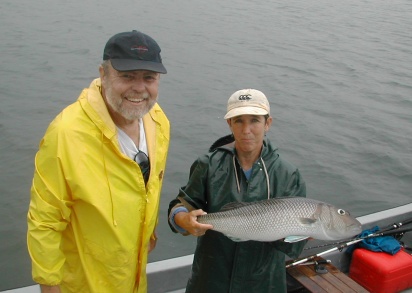
Bud & Connie with green jobfish
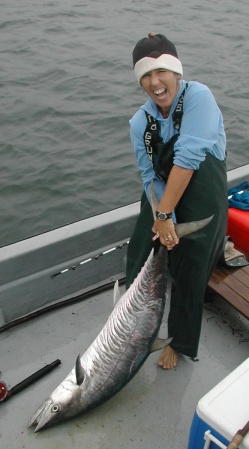
Connie’s 49 pound walu
S/V Cookie Cutter came in to the bay for one night on their way to Matasawalevu. Although we were familiar with their boat, this was the first time we met Peter and Connie (not the same Connie) – a very friendly couple from Victoria, BC. We looked forward to seeing them again in Matasawalevu.
Then our friends, Glenn & Renee, on S/V Learjet arrived in Kavala Bay on June 20. We talked over our plans to sail to the Lau group together on June 23, and we decided to leave Kavala Bay the next day to go to Matasawalevu Bay on the east end of Kadavu for two nights – one step closer to heading east.
We had not done much since arriving at Kavala Bay, and we had endured a tremendous amount of rain, but we had really enjoyed it. We left it hoping that we would be able to return.
We motored, in the company of S/V Learjet, from Kavala Bay to Matasawalevu Bay. We passed Waisalima, which is where Joe & Connie live, and Connie came out in her boat to guide us around the point in to Matasawalevu Bay.
When we arrived Matasawalevu, S/V Cookie Cutter was anchored there. It is a large bay with a steep shore and a large area of bommies near the center. It is a deep anchorage, and we motored around for a bit looking for a spot less than 70′. We were in about 30′ of water, and Nita was on the bow looking out for bommies. By the time she saw one particular bommie it was too late to turn away, and we had our first ‘close encounter’ with a Fijian reef. We just bumped it, and we were able to quickly back away from it, but it was unnerving all the same. Obviously keeping watch from the bow would not be enough. Nita would start going aloft to watch.
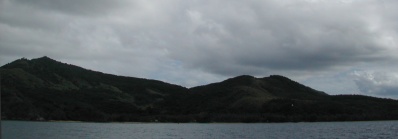
Large open Matasawalevu Bay
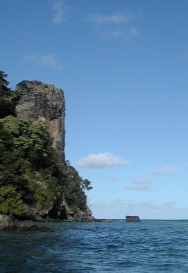
Dramatic cliffs
We went with Glenn & Renee (S/V Learjet) in to the village to make sevusevu. We drank a few bowls while there, but we needed to get back to the boats before the tide and sun fell any further, so we cut our visit a bit short. But the chief was very welcoming, and he gave us permission to fish, dive, whatever.
That evening, the guys (Bud, Glenn, & Peter) wanted to do a night dive. Nita didn’t want to dive, but she went along as surface support. We set off in two dinghys – Bud and Glenn in one, Peter and Nita in another. Peter and Nita ended up in very shallow water over reef, and Nita was now enduring her second undesired reef experience within a few hours.
It was wonderful to see Joe and Connie! They were our friends and neighbors at the Ala Wai Fuel Dock for a few years when they were planning on cruising themselves. However, after a few disillusionments, they bought an acre on the beach on the northeast coast of Kadavu, and they are living their island lifestyle from the stability of land.
Their place is quite beautiful, and it is hard to believe that they have been there just over two years. They and their daughter, Alex, seem to have found their niche. They are in their element.
Joe is currently working a lot and enjoying it. He is helping Tom Bashaw build a house here. Joe runs the job while Tom is in Hawaii. Joe also tends their numerous gardens. They have a large patch of yanqona, and they grow all of their fruits and veges. And in Connie’s characteristic generosity, she shared these with us, and they were delicious.
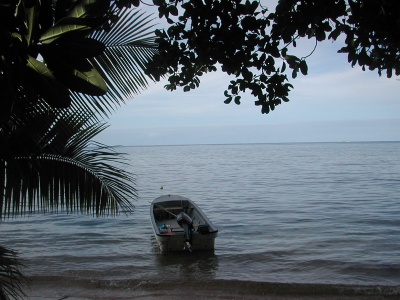
Connie’s boat & view
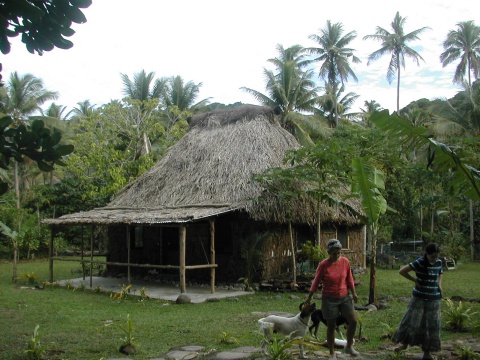
Connie & Alex outside their bure
Connie is involved in countless projects. She runs their home, and she is taking care of the books for Tom’s building project. She also home schools Alex and is involved in various community projects. For instance, on Tuesdays, Connie picks up moms and babies in her boat and takes them to the local health center for check ups. That is the only way to get around here. Connie also catches all the fish they eat. Around here, if you want to eat, you fish. And they eat very well.
They have dogs, a cat, chickens, etc. They have a traditional bure in which they sleep, and they also built a main house in which they spend most of their waking time. The main house if fully screened, so it is comfortable in spite of the voracious mosquito population. They have hot and cold running water and a flush toilet – all the comforts of home.
Their view is to the east, and it is breathtaking. Neither words nor pictures can do justice to what they have built here.
But again, our day had to be cut short because of falling tides (Connie’s boat gets beached at low tide). So we went back to Matasawalevu to get ready to sail to the Lau group the following morning.
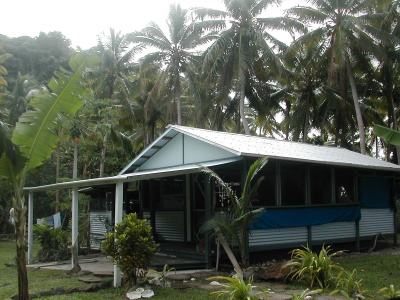
Main house
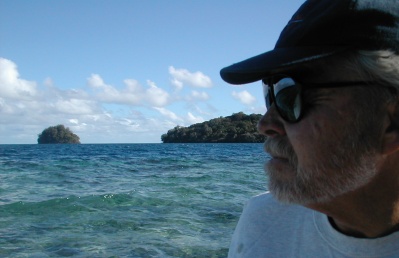
Exploring in dinghy
The diving at Matasawalevu was similar to the diving we found in the Lau group. There are still many fish, although most are small. The corals, however, are in very poor shape. The skeletons are still there, but most of them appear dead and are covered with silt. Very disappointing.
We discovered a narrow channel through the mangroves near our boat and went exploring. It took us through to the outside of the bay. We discovered that the large land mass just in front of our boat is actually an island at high tide. At low tide, the channel dries and one can walk between the two islands.
Because of the spring tides, we were unable to arrange a particular dive we wanted to do in Naigoro Pass. And we had a weather window in which we could travel, so we decided to head west toward Namalata Reefs – possibly our last stop on Kadavu. But it would be a long sail, so we would stop for one more night in Kavala Bay. We said goodbye to the east end of this beautiful island.
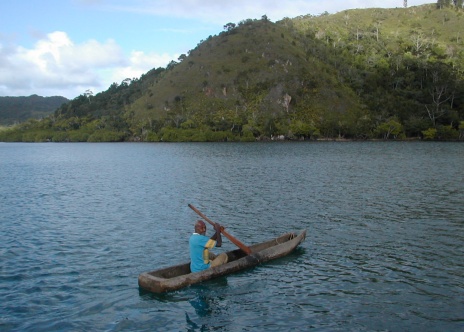
Visitor in dugout canoe
We did return to Kavala Bay for one night. Our weather window was still open, so we left Kavala Bay after only one night. We still find it a lovely bay with good holding and wind protection as well as friendly residents. A good find for a cruising boat.
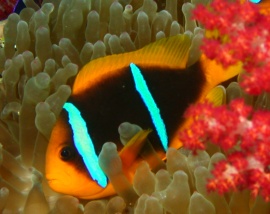
We found Nemo
We made sevusevu with the local chief, Cava, at the bar at Dive Kadavu – a nice resort. However, we were told that we could not dive unless with a divemaster from Dive Kadavu. We really wanted to find ‘awesome’, so we were ready to pay for adult supervision, but the weather dictated otherwise. It rained and blew for days. We had incessant two foot short chop inside the reef with winds varying between 20 to 36 knots. It was miserable.
When the winds and seas abated, we moved Passage around a corner and had a spectacular bay to ourselves. This was a very nice spot for a few days.
Although we were nearly ready to move on, we still wanted to find ‘awesome’, so we arranged for the dive boat to pick us up the following morning. They went right by without stopping for us – turns out we got bumped by some resort guests. But we did get out the following day, and it was – in a word – awesome.
The fish were plentiful and varied, but the corals were the highlight. The hard corals were healthy and colorful, and the soft corals were spectacular. They were healthy, plentiful, and extremely colorful. Such vibrant colors look almost artificial underwater. One of the dives we did was at a site called ‘coral garden’, and it looked like an overgrown flower garden.
We are very glad that we saw the corals here, but our placid anchorage grew rolly with a swell that wrapped around the point, and we had to move back to our original anchorage. It was calmer in there, but we were ready to move on as soon as it became calm enough to do so.
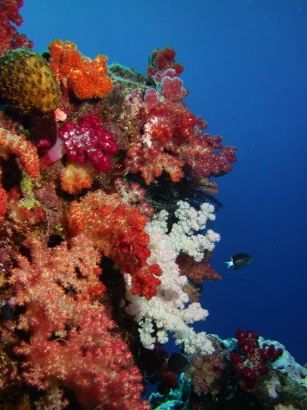
Awesome corals
Given the lousy weather conditions, we have continually changed our plans, and now they changed yet again. We had persistent northeasterlies, so a trip to Levuka, or even Suva, would have been brutal. So we headed west. We needed to do some provisioning before going remote again, so we headed for Lautoka – on Viti Levu’s west coast – for a few days. Then probably on to the Yasawas and Mamanucas.
Kadavu was a good experience, and we are glad we spent some time here. Now we will go see what the western islands have to offer. We would be very happy to find more diving like we found at Namalata Reefs.